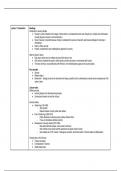Summary
Summary Overview Global Security (6442HGSY)
- Course
- Institution
This document contains a complete overview of the readings and lectures of Global Security (). This is perfect for studying and revising after you have done all the lectures because this perfectly summarizes everything you need to know! Good luck studying :) P.s. I also have a bundle up on my page...
[Show more]



